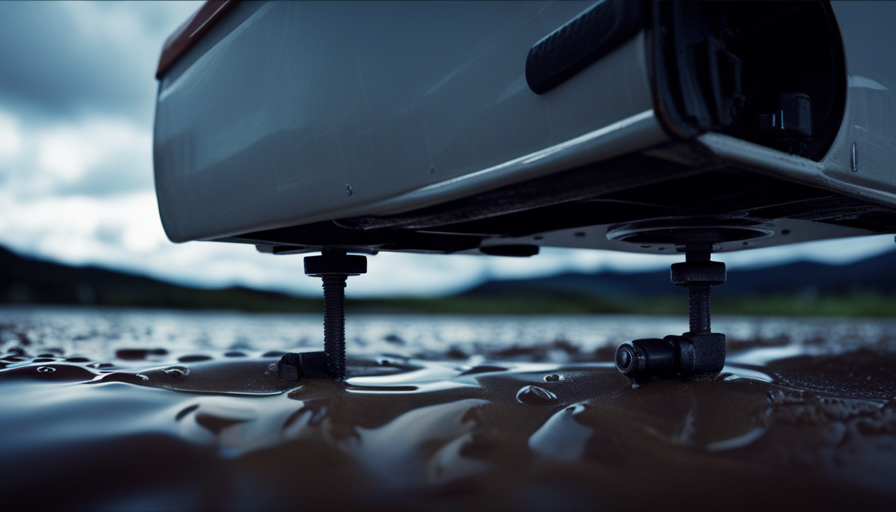Are you tired of dealing with the mess and hassle of water drainage in your camper? Well, get ready to be amazed! Presenting the amazing low point drain for campers, the perfect solution to all your drainage issues!
This ingenious device is a game changer, revolutionizing the way campers handle water waste. A low point drain is a remarkable system designed to efficiently remove water from your camper’s plumbing system. It’s strategically located at the lowest points in your camper, ensuring that every last drop of water is drained out. No more struggling with cumbersome buckets or messy spills! In addition to its efficient drainage capabilities, the low point drain also offers the added benefit of keeping your camper’s plumbing system dry and free from potential damage caused by standing water. This helps prevent mold and mildew from forming, extending the lifespan of your camper’s plumbing components. Overall, the benefits of dry bath in camper are numerous, saving campers time and hassle, while also promoting a healthier and more hygienic camping experience.
In this article, we will delve into the fascinating world of low point drains. We’ll uncover their purpose, explore their location in your camper, and reveal the importance of properly maintaining them. We’ll even provide step-by-step instructions on how to use these incredible drains.
So, buckle up and get ready to discover the wonders of low point drains in your camper!
Key Takeaways
- Low point drains in campers are valves that remove water from the plumbing system to prevent damage from freezing temperatures.
- Common issues with low point drains include clogging with debris or sediment and leaks caused by loose fittings or damaged pipes.
- Regular inspection and cleaning of low point drains is crucial to prevent expensive repairs and health risks.
- Winterizing tips for low point drains include draining all water before winterizing, using compressed air to blow out excess water in the lines, insulating drains with foam pipe insulation or heat tape, and considering the use of RV antifreeze.
Introduction to Low Point Drains
The low point drains on a camper are small valves that allow water to be drained from the plumbing system, resembling tiny faucets. These drains are essential for maintaining the integrity of the camper’s plumbing system and preventing damage from freezing temperatures. In addition to draining the water system, the low point drains also help to clear out any excess water that may have collected in the pipes, which can prevent potential leaks and water damage. It’s important to regularly open the low point drains to ensure that any trapped water is removed, especially before storing the camper for an extended period. This is especially important for campers with a wet bath in camper, as any excess water left in the plumbing system can lead to mold and mildew growth.
To locate the low point drains, follow these simple steps. First, ensure that the camper’s water pump is turned off and all faucets are closed. Next, crawl underneath the camper and look for two small valves, usually made of plastic or brass, located near the water lines. Once you’ve located the drains, simply open them by turning the valves counterclockwise. This will release any water trapped in the system.
While low point drains are relatively straightforward, they can sometimes present issues. Common problems include leaks, clogs, or difficulty in opening or closing the valves. To troubleshoot these issues, ensure that the valves are fully closed or opened, depending on the situation. If there’s a leak, check for any damage to the valves or water lines and replace as necessary. If a clog is present, use a pipe cleaner or compressed air to clear the blockage.
Understanding the purpose of low point drains is crucial for maintaining a functional plumbing system in your camper. [transition sentence] Let’s delve into the next section to gain a deeper understanding of why these drains are so important.
Understanding the Purpose of Low Point Drains
Get ready to discover why you absolutely need to know about this essential feature on your RV. Understanding the purpose of low point drains is crucial for any camper owner. Here are four key benefits of having low point drains:
-
Prevents freezing: Low point drains are designed to remove water from the pipes in your camper’s plumbing system. By emptying the water, you can prevent it from freezing during cold weather, which can cause damage to your pipes.
-
Easy maintenance: With low point drains, you can easily drain the water from your camper’s plumbing system for maintenance purposes. This allows you to flush out any debris or contaminants that may have accumulated over time.
-
Saves water: By using low point drains, you can efficiently drain the water from your camper’s plumbing system, minimizing the need for excessive water usage. This is especially important when you’re camping in areas with limited water resources.
-
Extends lifespan: Regularly using low point drains helps to extend the lifespan of your camper’s plumbing system. By preventing water from sitting stagnant in the pipes, you can reduce the risk of corrosion and other plumbing issues.
Now that you understand the purpose and benefits of low point drains, let’s explore their location in a camper.
Location of Low Point Drains in a Camper
Located in various areas throughout the RV, the position of low point drains is determined by the layout and size of the plumbing system, with some campers having as many as six drains. These drains are strategically placed to ensure easy access and efficient drainage of the water system.
Finding and fixing leaks in low point drains can be a common issue for RV owners. To troubleshoot low point drain issues, start by visually inspecting the drains for any signs of leakage, such as water dripping or puddling. If a leak is detected, it’s important to identify the source and repair it promptly to prevent further damage. This can involve tightening connections, replacing damaged components, or applying sealant as necessary.
Regularly inspecting and maintaining low point drains is crucial to avoid potential water damage and costly repairs. By properly maintaining these drains, you can ensure the integrity of your RV’s plumbing system and prevent any potential issues.
Transitioning into the next section, it’s essential to understand the importance of properly maintaining low point drains to ensure the overall longevity and functionality of your camper’s water system.
Importance of Properly Maintaining Low Point Drains
Make sure you don’t neglect the essential task of properly maintaining your RV’s water system to avoid costly repairs down the road! Regular maintenance of your low point drains is crucial to keep your camper’s water system in optimal condition.
Neglected drains can lead to potential problems that can quickly escalate into expensive repairs. When low point drains are not properly maintained, sediment, debris, and even insects can accumulate in the system. This build-up can cause blockages and restrict the flow of water, leading to decreased water pressure or even complete system failure. Additionally, neglected drains can become a breeding ground for bacteria and mold, posing health risks to you and your family.
To prevent these issues, it is important to regularly inspect and clean your low point drains. Flushing the drains with clean water can help remove any accumulated sediments or debris. Additionally, using a mild disinfectant can help eliminate bacteria and mold.
By properly maintaining your low point drains, you can ensure the long-term functionality and efficiency of your camper’s water system.
Next, we will discuss the steps to use the low point drain, which will further aid in maintaining a healthy water system.
Steps to Use the Low Point Drain
Feel the refreshing rush of cool, clear water as you release the hidden valve and watch as it gracefully empties your RV’s water system. Using the low point drain is a crucial step in the winterizing process and can help prevent damage to your camper’s water lines during freezing temperatures. Here are the steps to properly use the low point drain:
-
Locate the low point drain valves: These are usually located underneath your RV, near the water tank. They’re typically marked with a blue or red cap.
-
Open the valves: Twist the caps counterclockwise to open the valves. This’ll allow the water to flow out of the system.
-
Position a bucket or container: Place a bucket or container underneath the drains to catch the water. This’ll prevent any mess and make cleanup easier.
-
Monitor the drain: Keep an eye on the drain to make sure that all the water has been emptied from the system. Once the flow stops, you can close the valves by twisting the caps clockwise.
Troubleshooting common issues with the low point drain can help you avoid any potential problems. In the next section, we’ll provide tips for winterizing your camper’s low point drains without compromising the functionality of your RV’s water system.
Tips for Winterizing Your Camper’s Low Point Drains
To properly prepare your RV for winter, it’s essential to take necessary steps to protect your water lines from freezing temperatures, and one crucial aspect of this process involves winterizing the drainage system. When it comes to your camper’s low point drains, there are a few tips for preventing freezing that can help ensure your water lines stay intact during the cold winter months.
Firstly, it’s important to make sure that all water is drained from the low point drains before winterizing. This can be done by opening the drains and allowing any remaining water to flow out. Additionally, it’s a good idea to use compressed air to blow out any excess water that may be trapped in the lines.
Another tip for preventing freezing is to insulate the low point drains. This can be done by using foam pipe insulation or heat tape. These insulation methods can help keep the drains protected from freezing temperatures.
Lastly, if you’re looking for alternative methods for winterizing your camper’s low point drains, you can consider using RV antifreeze. This can be poured into the drains to prevent any remaining water from freezing.
By following these tips for preventing freezing, you can ensure that your camper’s low point drains are properly winterized.
In the next section, we will discuss common issues with low point drains and how to fix them.
Common Issues with Low Point Drains and How to Fix Them
Now that we’ve covered some tips for winterizing your camper’s low point drains, let’s discuss some common issues that you may encounter with these drains and how to troubleshoot them.
Low point drains can sometimes become clogged with debris or sediment, preventing them from functioning properly. If you notice reduced water flow or no water coming out of the drains, this could be the issue. To fix this, you can use a pipe cleaner or a small brush to remove any obstructions.
Another common issue is leaks in the low point drain system. This can be caused by loose fittings or damaged pipes. To address this, you should inspect the connections and tighten any loose fittings. If you find any damaged pipes, they’ll need to be replaced.
It’s also important to check the valves associated with the low point drains to ensure they’re fully closed or open, depending on your specific system.
By troubleshooting these common issues, you can ensure that your low point drains are functioning properly and ready for use.
Now, let’s explore the benefits of using a low point drain in your camper.
Benefits of Using a Low Point Drain in Your Camper
Imagine the freedom of effortlessly releasing the burdens of excess water from your mobile oasis, allowing your adventures to flow unencumbered. That’s the beauty of using a low point drain in your camper.
Not only does it provide a convenient way to remove water from your plumbing system, but it also offers several benefits that make it a must-have for any camper, especially during winter camping.
One of the main advantages of a low point drain is its ability to help with water conservation. During winter camping, every drop of water counts, and wasting even a small amount can be detrimental. With a low point drain, you can easily drain your water system, ensuring that no water is left behind to freeze and potentially cause damage. This not only helps to preserve your water supply but also prevents any costly repairs that may be needed due to frozen pipes.
In addition to water conservation, a low point drain is also more efficient compared to other drainage systems in campers. Unlike traditional drain valves that require manual opening and closing, a low point drain allows for quick and effortless removal of water. This means that you can spend less time dealing with draining your plumbing system and more time enjoying your camping adventures.
Transitioning to the next section, let’s now compare low point drains to other drainage systems in campers without compromising on efficiency.
Comparing Low Point Drains to Other Drainage Systems in Campers
Experience the convenience and efficiency of effortlessly removing excess water from your mobile oasis, allowing your camping adventures to flow unencumbered, as you compare different drainage systems in campers.
When it comes to draining water from your RV, there are various options available, but one of the most popular choices is the low point drain. Comparing low point drains to other drainage systems in RVs, it is important to consider the pros and cons.
Low point drains are strategically located at the lowest points of your camper’s water system, allowing gravity to do most of the work in draining the water. This system is especially effective in removing water from the plumbing lines, preventing freezing during winter months. On the other hand, other drainage systems, such as using a pump or manual draining, may require more effort and time.
One of the advantages of low point drains is their simplicity and ease of use. By opening the valves, the water is quickly and efficiently drained from the system. This eliminates the need for pumps or manual labor, making it a user-friendly option. However, it is important to note that low point drains may not be suitable for draining larger volumes of water, such as from the fresh water tank.
Comparing low point drains to other drainage systems in campers, it is evident that low point drains offer convenience and efficiency. However, they may not be suitable for all drainage needs. Understanding the pros and cons of low point drains will help you make an informed decision for your camper’s drainage system.
Transitioning into the next section, let’s explore some frequently asked questions about low point drains.
Frequently Asked Questions about Low Point Drains
Get ready to have your questions answered about the convenient and efficient way to remove excess water from your mobile oasis – let’s dive into some frequently asked questions about low point drains!
-
How do low point drains help with winterizing techniques?nnLow point drains are essential for winterizing your camper because they allow you to remove all the water from your plumbing system. By opening the low point drains, you can ensure that there’s no water left in the pipes, preventing freezing and potential damage during the winter months.
-
What are some common problems with low point drains?nnOne common issue is leaks. If you notice water dripping from the low point drain, it could indicate a faulty valve or a damaged pipe. Another problem could be clogs. Debris or sediment can accumulate in the drains, causing blockages and hindering the draining process.
-
How can I troubleshoot low point drain problems?nnIf you suspect a leak, inspect the valves and pipes for any visible damage. Tightening loose connections or replacing damaged components may solve the issue. For clogs, try using a plumbing snake or a high-pressure water hose to clear the drains. If the problem persists, it’s recommended to seek professional assistance.
Low point drains are invaluable for maintaining your camper’s plumbing system and ensuring its longevity. By understanding their function and troubleshooting common problems, you can enjoy worry-free camping experiences.
Frequently Asked Questions
Can I use the low point drain to empty my entire camper’s water system?
Using the low point drain to empty your entire camper’s water system has its pros and cons. One advantage is that it allows for a quick and easy way to remove water from the system. However, it may not completely drain all the water, leaving some residual water in the pipes.
To properly winterize the low point drain system, ensure all valves are closed, open the drain valve, and then use compressed air to blow out any remaining water.
How often should I clean and maintain my low point drains?
To properly clean and maintain low point drains, regular maintenance is essential. Here are some tips for maintaining low point drains on your camper:
-
First, locate the drains and make sure they’re free from any debris or obstructions.
-
Next, use a hose or pipe cleaner to flush out any accumulated sediment or residue.
-
Finally, check for leaks or damage and repair as necessary.
By following these steps, you can keep your low point drains in excellent condition for efficient water system operation.
Are low point drains only found in specific types of campers?
Low point drains can be found in various types of campers, providing numerous benefits. These drains are designed to remove water from the plumbing system, preventing damage caused by freezing temperatures. They are commonly installed in motorhomes, travel trailers, and fifth wheels.
By allowing the water to flow out of the lowest points in the system, low point drains help protect pipes and fixtures from bursting. This ensures a longer lifespan for your camper’s plumbing and reduces the need for costly repairs.
Can I use the low point drain to regulate the water pressure in my camper’s plumbing system?
Yes, the low point drain can be used to regulate the water pressure in a camper’s plumbing system. By opening or closing the low point drain, you can adjust the flow of water through the system, which in turn affects the water pressure. This can be particularly useful in preventing water leaks.
By properly regulating the water pressure, you can ensure that the plumbing system is functioning optimally and minimize the risk of damage or leaks.
Is it necessary to use a low point drain if I already have a drain valve in my camper?
Using a low point drain on a camper has its benefits compared to using a drain valve. A drain valve is designed to empty the entire system, but a low point drain is specifically located at the lowest point in the plumbing system. This allows for better removal of water and sediment that may accumulate in the system.
Additionally, using a low point drain helps to prevent freezing of water lines because it allows for complete drainage of the system.
Conclusion
In conclusion, low point drains are an essential component of a camper’s plumbing system. They serve the purpose of draining water from the pipes to prevent freezing and damage during the winter months. Proper maintenance and usage of low point drains are crucial to ensure their effectiveness.
By following the steps to use the low point drain and addressing any common issues that may arise, campers can enjoy a worry-free experience. For example, John, a camper from Colorado, recently used his low point drain to remove excess water from his pipes before a freezing night, preventing any damage to his plumbing system.










